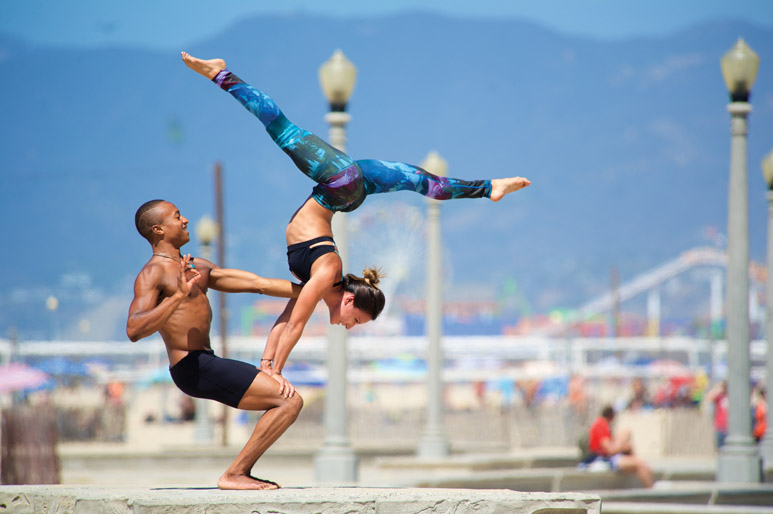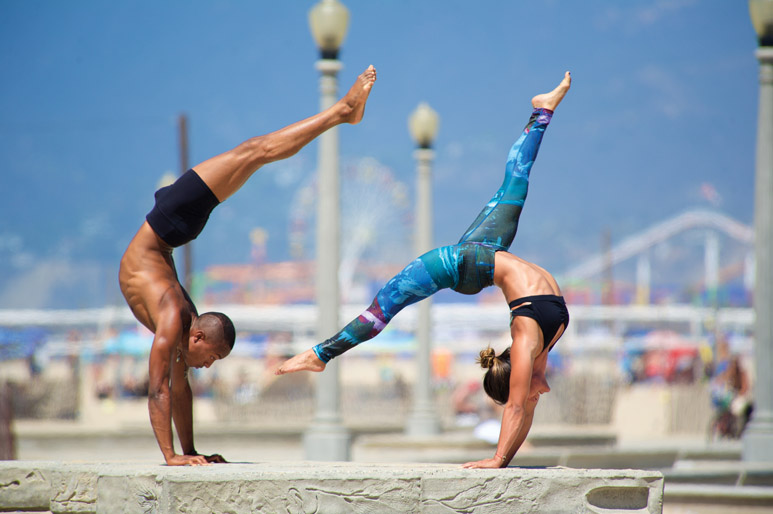Supporting Community Through Movement and Play
by Andrew Sealy
Imagine a practice where students literally and figuratively elevate one another. A practice where creativity and self-expression are encouraged, and working together to shape effortless union is the goal. A practice that draws hundreds of yogis to a 40 x 40 foot square lawn, notably called “The Green” in Santa Monica, every Sunday to move, connect, and play. A communication-based practice built on trust and connection that has been shared worldwide and continues to grow rapidly with thriving communities in over 83 countries. This is AcroYoga.
While AcroYoga has its base in the philosophy of Yoga, it is more than a dramatic and eye-catching partner yoga form. This practice teaches us something valuable about relationships—with ourselves as well as our tribe since the ability to connect is integral to relevant relationships. Connection is the core of AcroYoga.

My first experience of the power of connection through AcroYoga was at one of the community’s AcroYoga Jams more than three years ago. We had just finished the final module of our 200-hour training and our teacher Rocky, brought us to an AcroYoga Jam in a San Luis Obispo park. When Rocky first mentioned AcroYoga, I thought it would be an advanced technique beyond my reach. Little did I know that this accessible practice would transform the way I communicate and draw me closer to a network of yogis who are positively influencing the world through divine play and healing touch.
There was a sense of magic at play when we first stepped onto the grass field, where I immediately saw a group of yogis supporting each other. Some were standing with their feet on their partner’s knees, balanced only by the connection of their hands, while others watched closely to learn the moves. We joined in and I found myself on the grass with my friends trying to balance one another’s hips to feet, and hands to hands.
I discovered that with the support of our friends, my teacher-training partner Molly and I were able to execute beautiful asana with only a few minutes of practice. In these poses, I felt a deeper sense of our underlying connection. Adjusting to Molly’s movements while finding my foundation on my back was a surprisingly grounded feeling. I had never experienced anything like it, it was a little like legs up the wall holding a 100 pound sand bag with a mind of its own. Little by little, we found the sweet spot where everything was stacked, stable, and easy. We locked in, eye to eye and hand to hand. The uncomfortable vulnerability began to dissolve as time stood still. The connection of our hands, eyes, and feet to hips was intimate and healing. It’s not often that you hold someone in your hands and balance them from falling. At first it was confronting; we had to communicate and assess our alignment to make sure everything was placed correctly.
We both felt that practicing with a partner in this way increased the engagement and fun factors compared to a solo yoga practice. Once we moved through the first few seconds of uncomfortable vulnerability, we entered the flow state in which we explored support, created shapes, and enjoyed intuitive yoga creativity. It was like a mix of salsa dancing and Twister. “This foot goes here, that hand goes there, and voila, we got it: BIRD!” My first AcroYoga pose! It felt exhilarating to balance another full-grown yogi on my feet.
In those first 10 minutes, I realized that I loved AcroYoga. I spent the next two years expanding my understanding of the practice. Almost every Wednesday, I returned to that park to lean on the support from my peers. I realized how the partnership and human interaction that AcroYoga provided filled a deep need in me. I felt nourished and welcomed into a community that challenged me to step outside my comfort zone and celebrated collective achievement. The practice even brought me closer to people I thought I once knew.
Most importantly, I was captivated by the personal transformation I witnessed taking place within my own heart. I went from guarding my heart from being hurt to allowing myself to be vulnerable for the most authentic aspects of myself to shine through. When I practiced AcroYoga with Molly, I could move intuitively and we laughed when things when awry. It was fun to fall and even more fun to support each other through mutual accomplishment. When we accomplished a new flow or pose, it was a mutually shared celebration.
Through these experiences, I realized AcroYoga is more than just a style of partner yoga, it is a community of creative thinkers and active problem solvers. I witnessed how the AcroYogis took care of the park, looked out for one another, and brought wonder and imagination to the other communities they were involved in. I observed how AcroYoga breaks down fear and builds up genuine trust. On many occasions I have witnessed AcroYogis trying a new move with a spotter to make sure everything was safe. AcroYoga became a team practice where the smallest community equals three, and it made new things fun trying to switch roles and collaborate on fresh perspectives.
Soon after my first AcroYoga experience, I moved from San Luis Obispo to Seattle; later I moved from Seattle to Orange County. In all of these places I found thriving and unique AcroYoga communities. After two years of flying in these cities, I arrived in Santa Monica, in the midst of the SoCal hubs for yoga, conscious movements, and creative community. I was welcomed with open arms to a community that was ready to help me take my practice to the next level.
AcroYoga: An Introduction
AcroYoga comes from the Greek root Akros, meaning High and the Sanskrit word Yoga meaning Union. Together they form AcroYoga: High Union. AcroYoga is a community-based practice that encourages personal transformation through partner poses and genuine human connection. AcroYoga invites you to experience the full spectrum of your being through opportunities to give and receive, support and be supported, experience strength and sensitivity. It is a systematic approach to health and healing, designed to be accessible for everybody no matter shape or size. The best part about it is that it is fun to watch and even more fun to do. It brings people together the old fashioned way, through human interaction, touch, and play.

AcroYoga: Roots in Modern Yoga
One of fathers of modern yoga, Krishnamacharya, was a pioneer in the blending of acrobatics with yoga. There is footage online from 1938 of Krishnamacharya flying his children and students in postures similar to modern AcroYoga.
The modern AcroYoga practice, community, and organization first came together through play. Co-founder Jason Nemer met AcroYoga’s other co-founder, Jenny Sauer-Klein, in 2003 when they were introduced in San Francisco by mutual yoga friends. Jason had trained and competed at the Olympic level in gymnastics and was also a skilled acrobat. Jenny had both taught and studied Contact Yoga and partner flying massage. Their initial meeting turned into the first AcroYoga Jam — a spontaneous exploration of poses that lasted for hours. It was Jenny’s first time playing with the high-level hand balancing and Jason’s first time receiving therapeutic flying. Now both of those are foundational to AcroYoga.
Creative brainstorming led to the development of a partner practice that would blend their passions and talents. In January 2004, they taught a life-changing partner doubles acrobatics class. AcroYoga as a system was born. Twelve years later, AcroYoga is practiced in 83 countries with more than 650 teachers who share the practice with enthusiastic yogis willing to move, connect, and play in a new way.
AcroYoga around the World
In the Los Angeles area, there are over 20 AcroYoga Jams in any given week, where practitioners learn from each other and play freely facilitated by community leaders called JAMbassadors. In addition to Jams there are organized classes taught everywhere from yoga studios to community centers. The AcroYoga organization hosts Divine Play annually in Portland, the largest convergence of AcroYogis worldwide.
You can even go on an educational vacation with the community; at AcroYogaFest Jamaica teachers share their skills in more than 30 classes over seven days. The 2016 retreat will be April 18-25 at Jake’s Hotel on Treasure Beach. The people of Jamaica are excited for both the event and community-building that AcroYoga has done to bring positive touch awareness to the schools and children of Jamaica.
At AcroYoga.org there is a functional map that lists all the active JAMbassadors and teachers who host Jams, classes, and immersions worldwide. If your area doesn’t have a teacher, anyone can apply to be a JAMbassador and will be given the tools to build their own community by the AcroYoga organization. The website also hosts a list of structured classes that support the prominent philosophies in AcroYoga to “Know Thy Self, Support Others, and Enjoy Community.”
Andrew Sealy is a connection catalyst, yoga artist, and movement creator. His days are spent traveling to find adventure, practicing to cultivate growth, and constantly absorbing wisdom to creating new experiences that he shares with love, to friends around the world. Andrew’s teachings aim to answer the question: How can we adapt to create and evolve to sustain? yogarevealed.com
Jake Falzone is a photographer who finds that capturing life through yoga has brought him more human connection than he could have imagined. He’s learned that sunrises are nature’s cure for life’s little hangovers, while sunsets are the dessert we’re treated to at the end of each day. activexfocus.com
